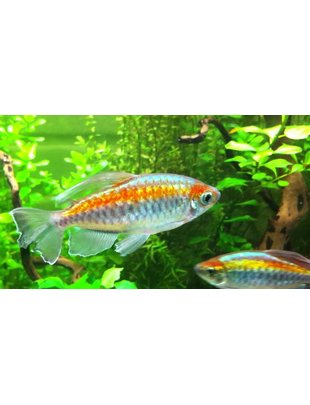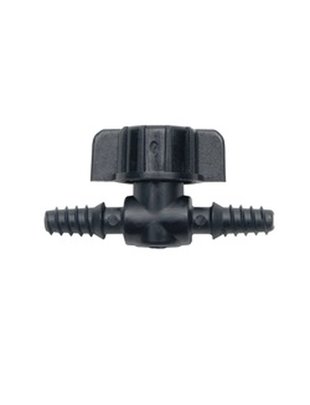Loach - Dojo (Md)
| Article number: | 03510 |
| Availability: | In stock |
| Delivery Means: | Pick Up in Store or Overnight Shipping "Special Shipping" |
Loach - Dojo (Md)
The Dojo Loach, scientifically known as Misgurnus anguillicaudatus, is a nocturnal fish meaning it is more active during the night and restful during the day. This unique fish has acquired the name Weather Loach from its fascinating ability to predict when a storm is rolling in. Its warning signs are displayed through body language. Signs they will provide you with increased swimming activity and will even jump or splash around.
The lifespan of a Dojo Loach in its natural habitat is generally around ten years, and while living in captivity their lifespan can range from five to eight years. These fish grow on average eight to ten inches, but can even reach 12 inches when fully grown. Reaching their maximum growth will take an average of three to four years. The Dojo Loach grows very quickly until they reach about five inches, and significantly slow down to about a little over an inch a year for the next two or three years. This fish is quite hardy as it can live in cold or tropical water aquariums. Dojo Loaches can assimilate to various climates; however, they thrive best in colder conditions. Living in warmer tropical temperatures can greatly reduce the Dojo’s life span by four or five years. Dojo Loaches can live up to a decade when raised in ideal conditions and even grow up to a foot long.
Dojo Loach Care
The Dojo Loach is a hardy fish being able to live in various conditions like living in a wide range of temperatures. Due to their hardiness, they can survive in low and high-temperature extremes. Though they can survive in a wide temperature range they thrive best in a tank temperature of 68 to 72 degrees Fahrenheit, 15 to 25 degrees Celcius. Even though Dojo Loaches have the unique ability to easily adapt tank temperature should not fluctuate much throughout the day as this can easily cause them stress. Other than water temperature Dojo Loaches are not extremely sensitive to the water chemistry of their tank. This fish can thrive in pH levels of anywhere from 6.0 to 8.0. The Dojo Loach should be kept in cool water temperatures with a pH level of slightly acidic to slightly alkaline to live a healthy life span.
The Dojo Loach is an omnivorous fish meaning they eat both animals and plants. These fish are bottom dwellers, so selecting food that can sink to the bottom is the best choice. Providing a balanced diet to give your Dojo Loach all the nutrients they need to stay healthy will consist of pellet foods and living things. Good meal options can include sinking pellet food, worms, insect larvae, and small crustaceans such as shrimp. Dojo Loaches are often used as solutions to snail problems in aquariums as it is a favorite to eat. Pairing these two together often leaves no snails left in the tank. Algae is not a snack Dojo Loaches will usually gravitate towards, but they do enjoy algae chips. Your Dojo should be fed pellets three times daily, and two or three times a week they should be fed a meal rich in protein such as shrimp, worms, or snails. Due to their social nature, you may even be able to feed your Dojo from your hand! As a general rule Dojo Loaches should be fed an average of three times a day with sinking pellet food or some living foods they will be able to hunt.
Dojo Loach Fish Tank Care, Size & Tank Mates?
Dojo Loach Tank Setup & Tank Mates
When choosing a tank to create your Dojo Loaches forever home thinking about their size when fully grown is important. They should be kept in a tank of at least 40 gallons or larger. Looking into the dimensions of the tank is essential as they will need plenty of room to swim around the bottom of the tank. Since these Loaches grow to about a foot long length and width are the most important dimensions to pay attention to when selecting a tank. The height is not quite as important unless you want to provide upper-level tank mates. Because of their playful nature, their tank should also include a tight-fitting lid to prevent them from jumping out. If this were to happen Dojo Loaches have a unique ability to survive out of water for a few hours so more times than not they will be perfectly fine. The Dojo Loach requires a large tank to offer them enough room to swim around the bottom of the tank as they are bottom dwellers.
When setting up your Dojo Loaches tank it is good to know that they do not need elaborate decorations, but giving them a few hiding spots will be appreciated. The bottom of the tank should be covered in a soft substrate such as smooth pebbles or a fine sandy substrate. This is because Dojo Loaches love to slither under the sand. A sharp substrate can damage their fragile soft scaled skin and possibly cause infection if they are cut. Plants that can tolerate the cooler temperature of the tank can be great auditions, but rooted plants may be dug up due to the Dojo’s stubborn nature. Aquatic mosses or ferns may be a better fit since they will cling to decorations in the tank. Driftwood can also be a good addition to your Dojo Loaches tank as it will provide them with more hiding spots to relax. Dojo Loaches do not require an elaborate tank all they need is a soft substrate to burrow into and a few covered hiding spots.
Selecting tank mates for a Dojo Loach is relatively easy as this fish is often very peaceful with others and is a great community tank choice. They can become aggressive with smaller fish if they become hungry. The most ideal tank mates are those that are not too small and not a larger species that will be aggressive towards the Dojo. These fish do not typically exhibit a schooling nature, but they should be in groups of three or more because of their social nature. Finding tank mates for a Dojo Loach will be quite simple as long as these fish are not aggressive and can thrive in cooler temperatures.
Goldfish are a great compatible tank mate to Dojo Loaches as they occupy the upper levels of the tank, so they will not crowd each other. Goldfish eat floating flake food, so feeding will not become an issue. Any leftover flakes that sink to the bottom will become a good snack for the Dojo Loaches. These two fish also thrive at the same temperature of 68 to 72 degrees Fahrenheit.
Kuhli Loaches could be compatible, but their temperature requirements would become an issue. Kuhli Loaches need to live in tropical temperatures of 75 to 86 degrees Fahrenheit when the Dojo Loach needs cooler temperatures. Pairing a Dojo Loach with a Kuhli Loach will greatly shorten their lifespan due to the warm temperatures.
A tank mate to avoid pairing with your Dojo Loach are shrimp. If you are wanting to keep shrimp in your aquarium think about keeping them in a separate tank as the shrimp will soon become a snack to your Dojo.
Dojo Loach Diseases
The Dojo Loach is more susceptible to diseases than other aquarium fish due to its thin tiny scales. Diseases found in these fish are more often than not parasitic infections such as ich. Ich, also known as white spot disease, is a highly contagious parasitic infection. It can be caused by adding infected fish into the tank, adding infected water, or not properly sanitizing your cleaning equipment. Ich causes white spots all over the body. Signs other than the tiny white spots include frequent scraping against tank objects, scale loss, and loss of appetite. This disease is commonly treated by manipulating the water temperature to eliminate the parasite. This can be tricky though because temperature manipulation can easily stress out your fish. Treatment is best advised by an aquatic veterinarian to take the best plan of action specific to your fish. White spot disease can be prevented by keeping pristine water conditions and quarantining new fish and plant additions for four to six weeks before incorporating them into your tank.
A common issue found in the Dojo Loach is bloating. Bloating can be caused by many factors, but the most common causes are parasitic infections and can also be caused by feeding habits. Treatment may take some trial and error to determine the root of the cause. Starting with antibiotics is always a good start as a parasitic infection should be treated as a priority. Parasitic infections can be treated by antibiotic medication administered through the mouth or feeding pellets soaked in the medication. If this plan of action does not show results bloating could be caused by feeding habits causing constipation. This can be treated by giving an easy-to-digest diet such as pellet food. Diseases can be a common issue found in the Dojo Loach as they are easily susceptible so keeping pristine tank conditions is essential.
Breeding Dojo Loaches
Unlike the simplicity of caring for a Dojo Loach, breeding does not come quite as easy. Breeding this fish does not often happen purposefully in home aquariums due to the months of preparation it takes. The Dojo Loach reaches sexual maturity between two and three years old. Once your Dojo has reached sexual maturity beginning the breeding process will take months of preparation as you must simulate their natural conditions in the tank. Dojo Loaches in their natural habitat breed during the spring months while the water is still cool before the warming months of summer. Throughout the winter months, lighting should be reduced and gradually increased into the spring months. The cold water in the winter months is what stimulates the breeding process, so the Dojo Loaches tank should be kept in a cool room to slightly lower the water temperature. Once spawning has occurred between the male and female she will lay around 50 eggs that will hatch within an average of three days. Once the female Dojo Loach has laid her eggs they should be removed and placed in a separate tank to prevent them from being eaten. Some fish are nurturing parents and will protect their fry until they can fend for themselves, but the Dojo Loach is not one of these. The small eggs may soon become a meal to your Dojo if not removed. Breeding the Dojo Loach is not a simple task, but with the proper months of preparation, it can be done within home aquariums.
Common Name - Dojo Loach
Origin - Southeast Asia
Temperature - 68-76°F (20-24°C)
Size - 6-12 inches
Minimum Tank Size - 40 gallons
Food & Diet - Omnivorous diet
Lifespan - 7 to 10 years
Water pH - 7.0-8.5
Tank Mates - Goldfish, White Cloud Mountain Minnows, and Kuhli Loach
Breeding - Male wraps around the female to fertilize released eggs.
Disease - May be susceptible to Ich.






